If you raise pigeons, you know pigeon gender identification can be challenging especially for young pigeons. There are several techniques that pigeon breeders and avians recommend for identifying pigeon gender. I have discussed all of those techniques in this article.
Male and female pigeons have several physical and behavioral differences. For example, males are slightly greater, more aggressive, and have less distance between vent bones. Paired pigeons are even easier to identify, the males feed the females, and frequently bow and scrap during the mating rituals.
Apparently, any one of these differences is enough to determine the gender but in some pigeons, both genders can have similar physical and behavirol characteristics. In such cases, the best solution is to check all the differences mentioned below to be sure of the pigeon’s gender. Let’s talk about all the differences.
Physical Differences Between Male and Female Pigeons
The head, beak, toes, tail, and vent bones of a pigeon can help determine its gender.
1. Body
Generally, male pigeons are bigger and heavier than females. The difference is insignificant in baby pigeons.
2. Head
Males have bigger heads and their heads are slightly flat at the top.
3. Beak
Males usually have broader and shorter beaks as compared to females.
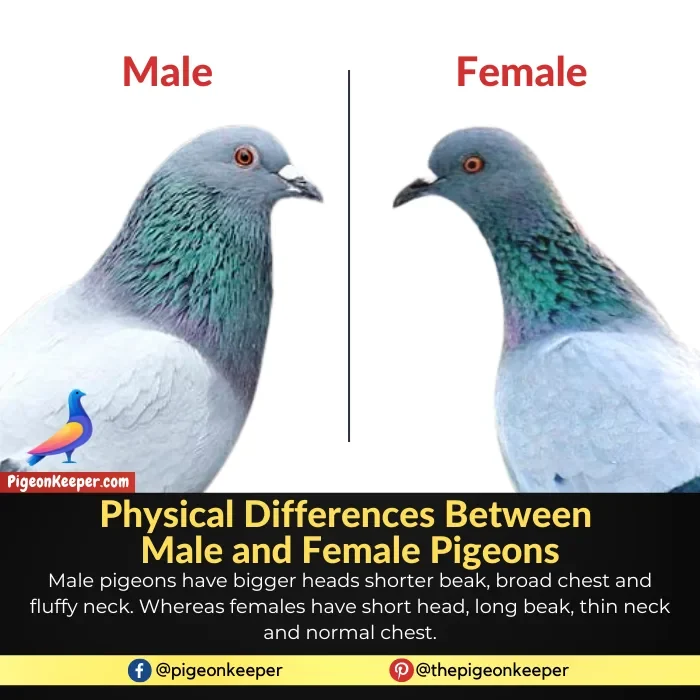
4. Neck and Chest
Since male pigeons coo a lot and puff out their neck feathers, their neck is thicker and their chest is broader.
5. Side Toes
The side toes of male pigeons are almost equal to the front toe but in female pigeons, the side toes are smaller. Don’t be confused with the back toe, it is always smaller than the front toe. Most of the females have thinner toes and legs.
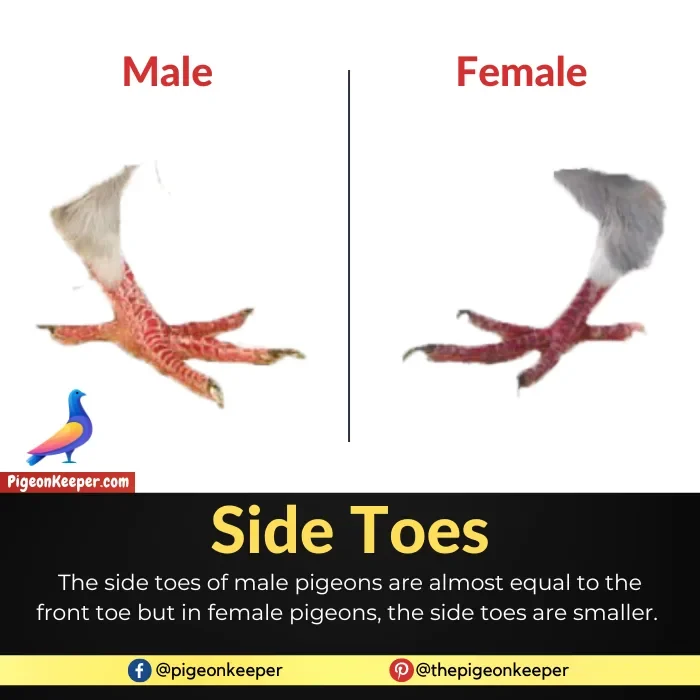
6. Tail
Another way to check your pigeon’s gender is to hold its wings, slightly swing the bird, and see its tail remains straight or goes in the upward position. If its tail goes upward, it is a female, if it remains straight, it is a male.
7. Vent Bones
The vent bones of female pigeons have enough gap to fit in your pinky finger. The males have small or no gap.
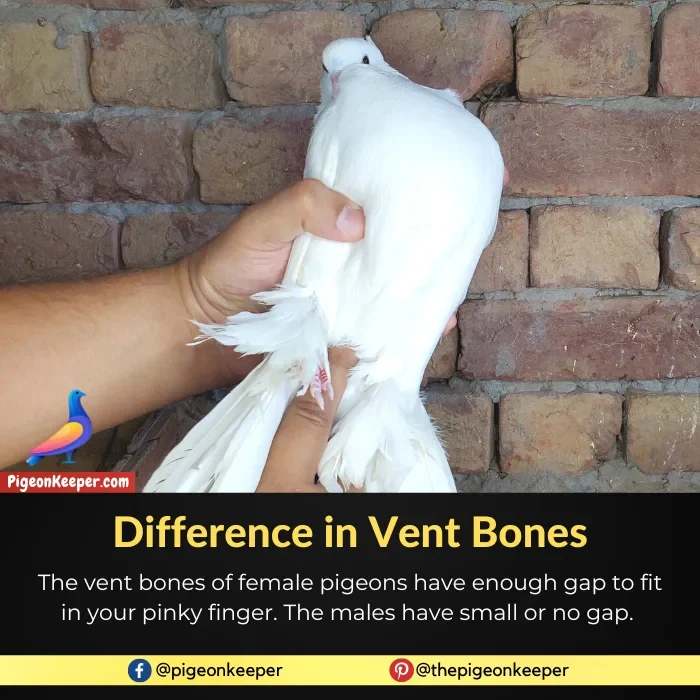
8. Vent Edges in Baby Pigeons
According to a research study, the vent edges of females are bigger than males. (1) The females have oval-shaped vent edges, both the upper and the lower edges are expanded out. Whereas males have horseshoe-shaped vent edges, the lower edge is less prominent as the upper edge covers it.
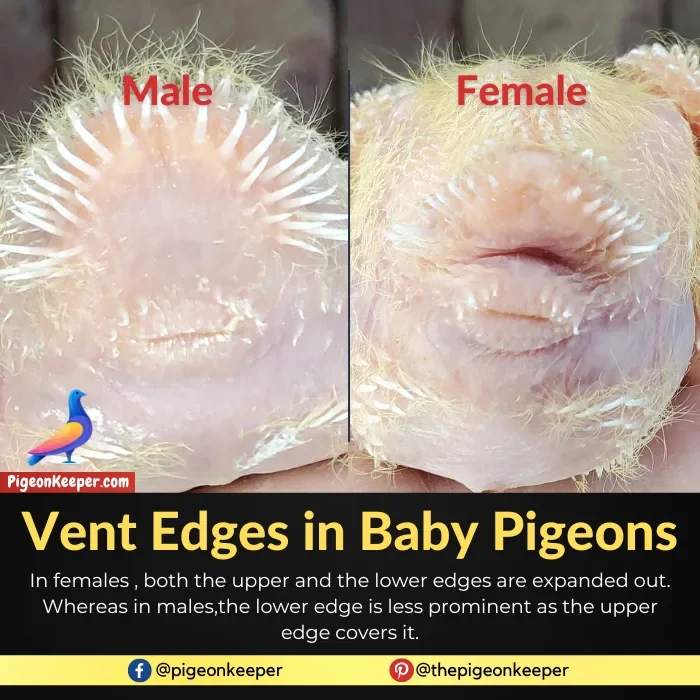
Behavioral Differences Between Male and Female Pigeons
Like physical differences, both genders have some behavioral differences too. You can identify the gender of any pigeon from a distance by just observing its behavior. Let’s discuss all the behavioral differences between males and females
9. Attitude Towards Other Pigeons
Male pigeons are usually aggressive towards other males. Females are usually calm, but they get aggressive only when they feel insecure.
Even if paired, male pigeons are less aggressive towards new females. They chase new females and try to mate with them. Whereas a paired female pigeon does not show interest to other males. This behavior makes it easier to judge the gender of new pigeons.
Place your new pigeon in a cage with a confirmed male pigeon. If the male pigeon chases the new pigeon and dances to attract the pigeon, your new pigeon is probably a female. If the male pigeon shows aggressive behavior, your new pigeon is probably a male.
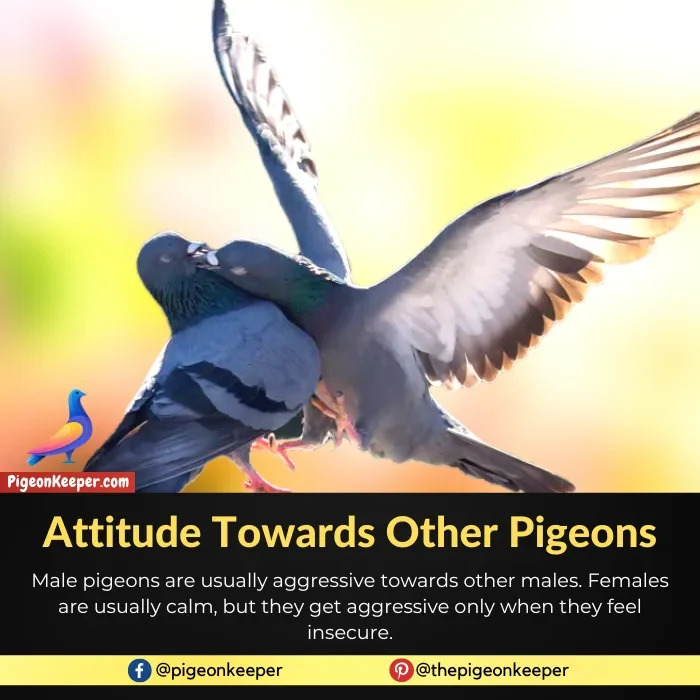
10. Feeding and Kissing
Male pigeons often feed the females; especially when the pair is near to breeding. The male opens its mouth, regurgitates the feed, and the female inserts its beak inside and takes the feed.
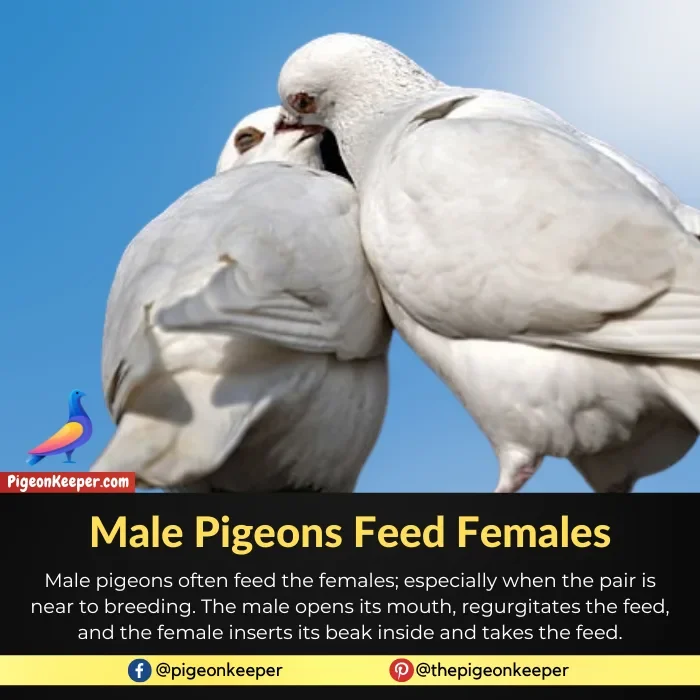
11. Mating Ritual: Bow and Scrapping
During mating rituals, the male chases the female. With its chest pumped up, it frequently bows its head and scrapes tail to attract the female. If the female is interested, it slightly drops its wings and let the male chase it. Before the mating begins, the female bends and the male climbs on the female.
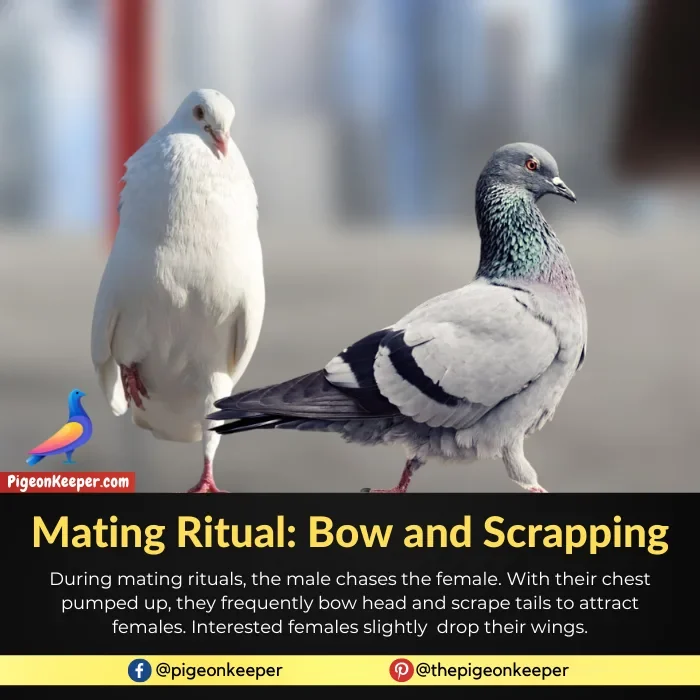
During a mating ritual, only the male coos; the female is less vocal.
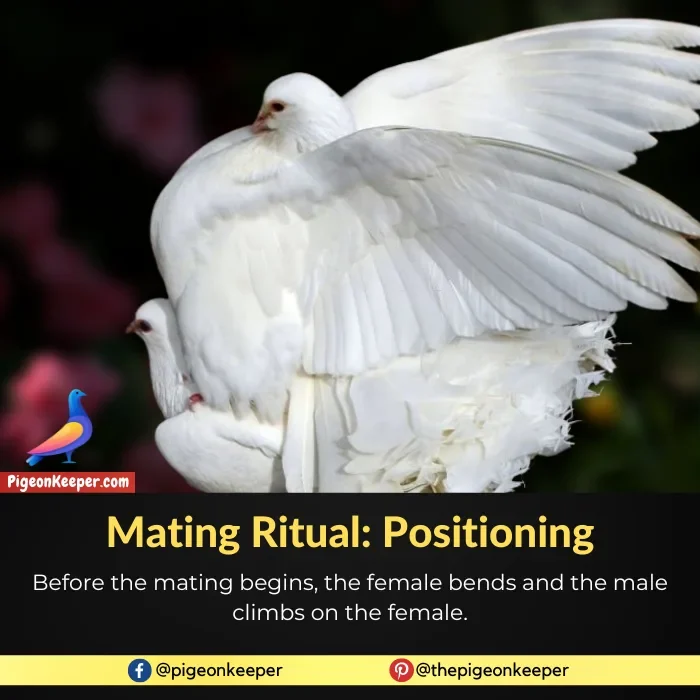
12. Egg Incubation
Both male and female pigeons incubate eggs. Females incubate the eggs for most of the day and the males incubate only for a few hours.
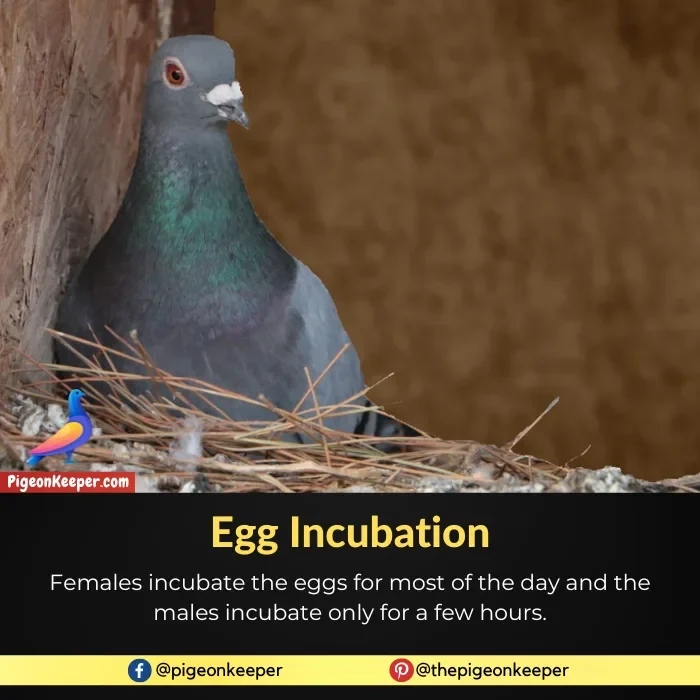
DNA Testing
The DNA test is performed by analyzing the pigeon’s feather, toenail, or blood sample. The process is a bit expensive and time-consuming but it is the most accurate and reliable method of pigeon sexing. DNA testing costs $19-23 in the USA. (2)
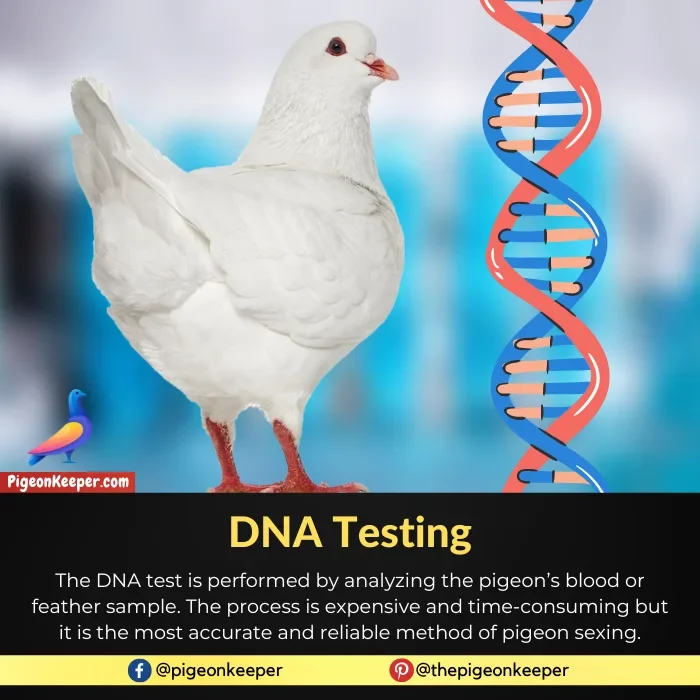
Incorrect Methods of Pigeon Gender Identification
There are some pigeon gender identification techniques that are commonly practiced but they do not work. Interestingly, these techniques have no scientific background and yet they are often portrayed as scientific methods.
Flip and Grip in Hand
It is believed, that placing a pigeon upside down on your palm with its head under its body reveals its gender. If it immediately jumps and stands, it is a male, if it stays in the same position, it is a female. I tested this technique on almost 15 pigeons of known gender and found this method worked on only 9 pigeons.

Pendulum Sexing
Some pigeon keepers believe that pigeons can be sexed with the help of a pendulum; which is impossible. The process involves testing a pendulum’s movement around the pigeon’s head. If the pendulum swings in a circular path, it’s a female, and if moves to and fro, it’s a male. I did test this method too and found it shows different results on the same bird. The pendulum’s movement has nothing to do with the bird’s head, it is your hand controlling the pendulum’s motion.
Although some pigeon keepers endorse pendulum sexing, it does not work and there is no scientific evidence of its authenticity.
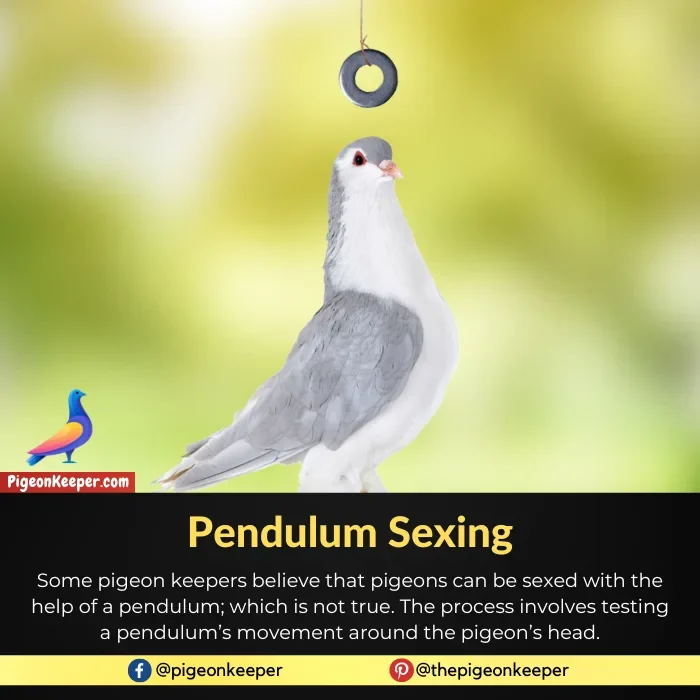
Final Thoughts
For experienced pigeon keepers, the easiest way to identify the gender of a pigeon is by checking the gap between its vent bones. Moreover, its behavior towards other pigeons (of known gender) is also another quick way. However, DNA testing is the most reliable but it is slightly expensive.
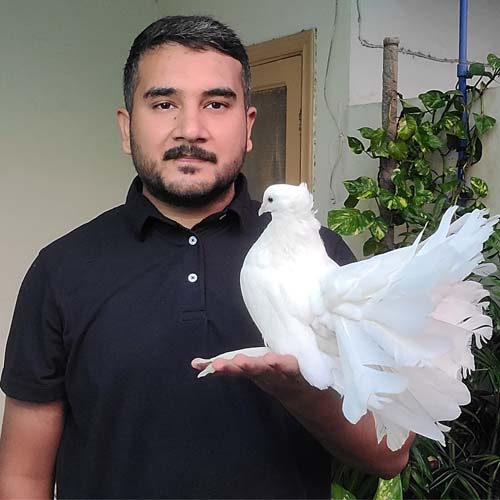
Bilal is a freelance writer and a content creator. He has been in the pigeon hobby for over 15 years. His deep interest in pigeon keeping enabled him to explore the development of various pigeon breeds and share them with the community.

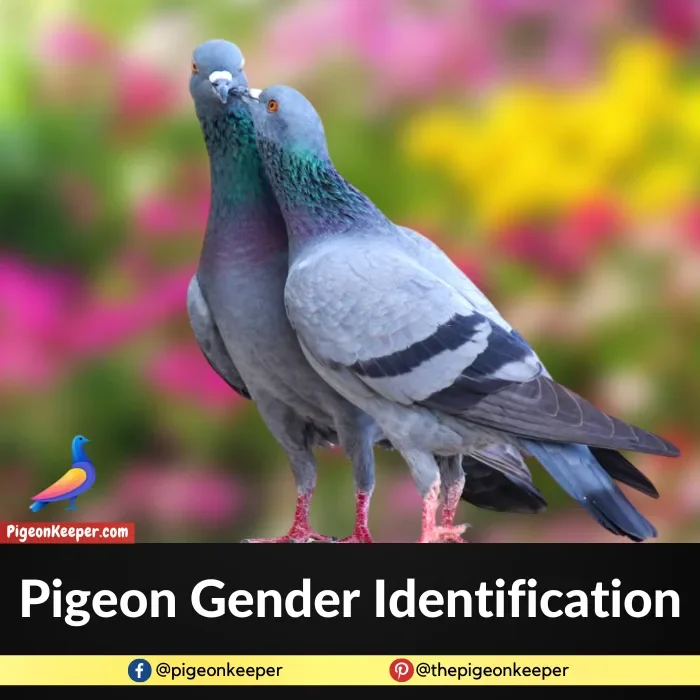
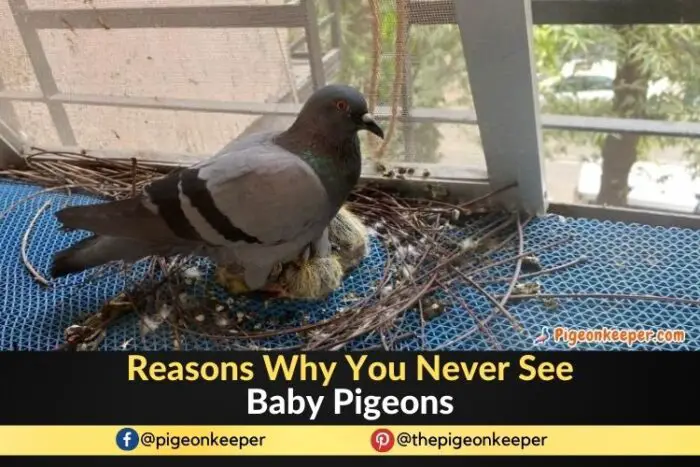
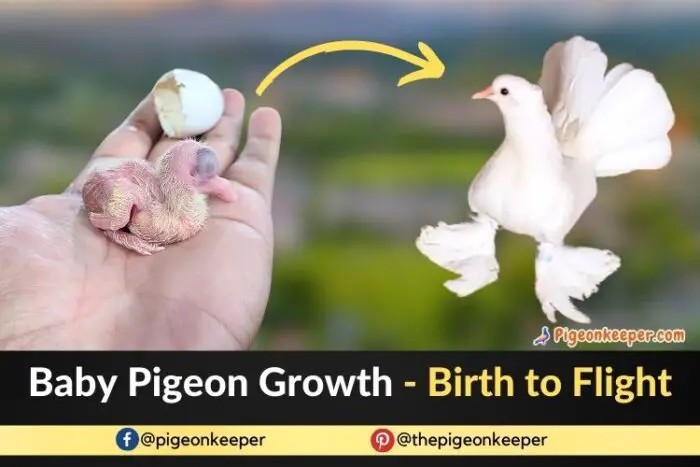

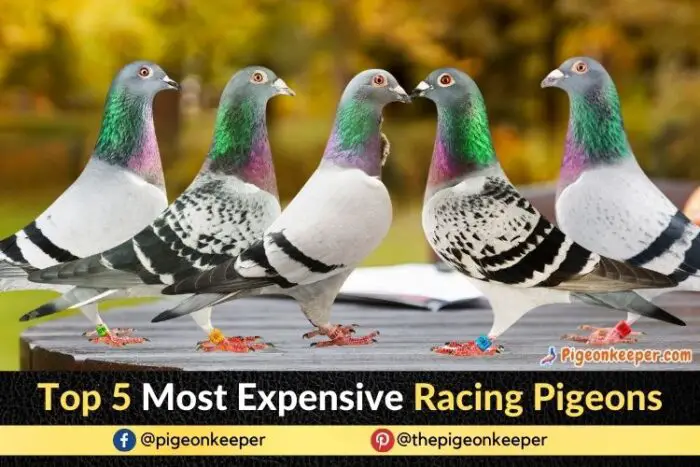
Verry informative article 👍
I found a pigeon in my garden two weeks ago. He could not fly, fully grown cats would get him if I don’t take him in. Kept him in an open carton with seeds and water with sugar and salt he ate well and drank but no flying. I checked his wings saw nothing broken. Took him out of the carton because I felt his muscles will stiffen up and he won’t fly so he’s been free in my empty apartment I have. He flies to the table and stays there with the food and water. Now flies to floor walks around like a chicken and back to the table but not any higher like the closet or the computer desk near window, or the window, I even put a stick there so he could coop on it, no.
It’s rainy and cold so I don’t want o let him out in the park where his friends are one block away, since he still does not fly strong he would freeze. He’s not afraid of me knows my voice is very smart. I think it’s a male but not sure. I never had pigeons I know nothing I love animals I hate to see him in trouble, there was a pigeon rescue near me in Queens on Queens Blv , NY but not any more. Once I found a pigeon and took him to them. I wish I knew where I could place him to rescue. Or a keeper but I don’t see any. Can you help me ? I don’t mind keeping him till spring and then take him to the park one block away as I feel he’s from there. He must of flown between the trees and fences and got hit
Because he landed by my fence and was eating there as I feed birds. At first he drank a lot and peed a lot his poop was all loose and green now it’s nice solid little circles.
That’s it, I’ve told you everything about him. He has nice feathers, no injuries, no bullets, nothing. Just his right wing was kind of shaking at first but now it’s fine. Close to the body just like the other. He flies up about 4 feet that’s it. And down 4 feet. He’s practicing this. Floor table table floor. Struts like a chicken and even wanted to peck at me at first but not now, knows me and looks me in the eye. Has nice red eyes. Shiny feathers, a bit purplish on the neck.
If you would write to my email it would be wonderful, I need guidance with him or her.
Mary Malkiewicz
Greenpoint Brooklyn 11222
Hi Marry, I appreciate your kindness. I am not sure about the situation, either the pigeon is adult but one of the wings is damaged (maybe an internal injury) or the pigeon is young, probably aged around 40-60 days. At this age pigeons usually eat themselves but they do not fly well. However, they start flying well after they age 75 days. Let’s hope this is the case. I recommend keeping him at least until spring and then take him to any near by park and swinging it in the air to make it fly. If it does not fly, then it might be injured. In such case, the pigeon cannot live a feral life, it needs care. I recommend contacting any local loft or zoo, they might adopt it. I wish I lived in Brooklyn, I’d have adopted the pigeon at once. Anyways, also go through this post: https://pigeonkeeper.com/where-to-buy-fancy-pigeons/ you might find a local breeder who might be interested. Best of luck 🙂
Bilal
Hello,
I have a pigeon that from birth is either blind, neurologically damaged, or both according to a vet I took him (her?) to. It was born under a tool shed and wandered away from the nest when it still had some yellow feathers and would just stand in one place all day long, ignoring me, cats, anything that approached. Until I intervened, it was fed by its parents. I taught it to self feed and drink. It now lives in a chicken coop near where it was born.
My question has to do with it’s sex. It is small and seems to have a lot of males interested in it, two of which have appeared to mate with it (although it greatly prefers one over the other). The males also periodically stand next to the coop, cooing or strutting. So that would argue that it is female. However, it has a thick neck like a male, behaves like a male (frequently vocal, puffs out and struts like the males who court it, fights with bushes, and can be a little feisty with me). My question is how much behavior is learned versus innate. Is it possible that this is a small male who is willing to be mate with other males just to have companionship? Or could it be a female who is mimicking male behaviors?
I checked the toes and they were inconclusive. What aside from DNA would you recommend I do to discover the sex? Thanks for sharing your thoughts.
Jackie
Hi Jackie, from the description, it seems like the bird is a male. Since it stays in one place, doesn’t move around much, and cannot chase away other males, it shows a behavior similar to females. It is also possible that over time it has developed a liking for other male pigeons, this is possible. Even if it is a male and is interested in females, I am not sure if it will be able to properly bond and mate with a female pigeon. I suggest you check its pelvic bones and carefully observe its head structure.
June 9th, we had two pigeon eggs hatch on our balcony of our apartment. The parents come and feed them multiple times a day. We do not disturb the “nest” (one of my flower pots). They are moving from on flower pot to another and flapping their wings. It’s been a wonderful experience watching this growth and nature. I was curious to know how long before these babies fly away?
I am getting a little anxiety over the mess on my balcony.
I feel you. Usually baby pigeons start flying at the age of 6-8 weeks and they permanently leave the nest by the age of 8-10 weeks. So they are not going to be around for long. You can find more information in this article: https://pigeonkeeper.com/what-does-a-baby-pigeon-look-like/